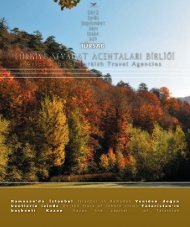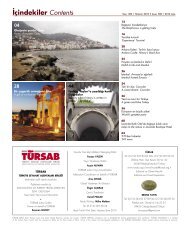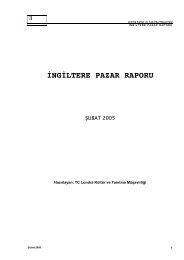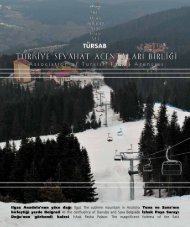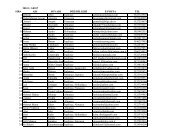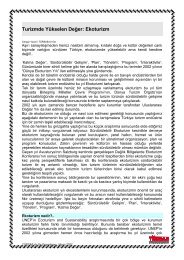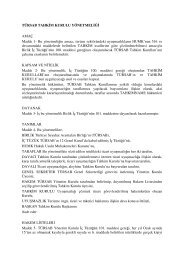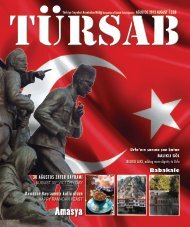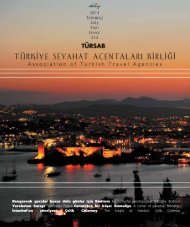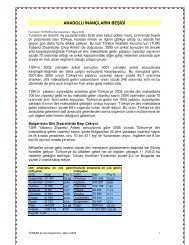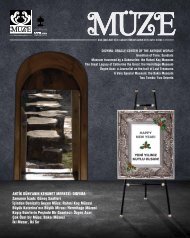döşenirken birer tuğla atlanarak yapılan ve merdiven basamağı işlevinigören çıkıntılarla bulmuşlar. İlkel fakat gerçek bir eko-mimari ürünü! Yazınserin kışın sıcak olan bu evler 150-200 yıl önce yapılmış. Kullanılan taşlar daantik şehir harabelerindeki kalıntılardan buraya getirilmiş.“<strong>Harran</strong> Kültür Evi”Bu evlerden biri, 1999 yılında o zamanki <strong>Harran</strong> Kaymakamı İbrahim HalilAkşit’in öncülüğünde restore edilmiş. 19 odalı ev “<strong>Harran</strong> Kültür Evi” olarakturizme açılmış. Bu ev, günümüzde de 10 çocuklu Ali Kızıl işletmeciliğindeturizme açık bulunuyor. Ali Kızıl, “...Çocuklarım yabancı dil konusundauzman olup, buranın tanıtımını yapmaktadırlar. Bakanlıktan takdir belgesive <strong>Harran</strong>’da ilk çalışma ruhsatını alan işletme de <strong>Harran</strong> Kültür Evi’dir”diyor. İbni Teymiye Mah. Çeşme Sokak No: 23 adresindeki evde toplugruplara sıra geceleri, yöresel yataklarda konaklama imkanı mevcut.(www.harrankulturevi.com)Dünyanın başka yerlerinde de var!MÖ 6000 yıllarına kadar inebilen bu tür sivil mimari örneklerinin,Mezopotamya ve Ege’de MÖ 3000 yıllarına kadar yaygın kullanıldığıbiliniyor. Anadolu’da bu tür evlere, en çok iki bölgede rastlanıyor.Birinci bölge Urfa ile Birecik arası, ikincisi de yine Urfa ile Akçakale arası.İkinci bölgede bulunan <strong>Harran</strong> evleri tuğla kubbelerle örülürken diğerbölgelerdeki evler kerpiçten yapılmış. <strong>Harran</strong> evlerindeki kubbelerintuğla ile örülmesinin nedeni yöredeki toprağın tuğla yapımına elverişliolmasından kaynaklanıyor. Bir başka neden de bu coğrafyanın çöl olması vebu yüzden de ağaç yokluğu. Kümbet evlerin dünyadaki diğer örneklerineMusul, Tiflis, Kıbrıs’ta, İtalya’nın güneyinde, Adriyatik Denizi’ne kıyısı olanPuglia bölgesi kırsalında, İskoçya, İspanya, İran, Afganistan, Çin ve Peru’dada rastlamak mümkün. İskoçya adalarında “Arı Kovanı” (“beehive houses”)adı verilen bu yapılar 18. yüzyılda çok canlı bir gelenek oluşturuyormuş.<strong>Harran</strong>’ı Koruma mı Dönüştürme mi?1979 yılında arkeolojik ve kentsel sit alanı olarak tescil edilen ve kubbelievleri korumaya alınan <strong>Harran</strong>’da, ören yerinden malzeme toplanması,her çeşit inşaatın yapılması, kanal açılması yasaklanmıştı. O tarihlerde960 kubbeli ev sayılan <strong>Harran</strong>’da bu sayı bugün 500 dolayında. 2000’deUNESCO Dünya Mirası Listesi adayı olan <strong>Harran</strong>’ın tam aday olabilmesiiçin Kültür ve Turizm Bakanlığı’nın yeniden yaptığı değerlendirmedensonra “kale ve surların onarılması, kümbet evlerin betonarme yapılardanarındırılarak koruma altına alınması ve onarılması, tarihi dokuya uygunyaşam alanlarının oluşturulması ve çevre düzenlemelerinin yapılmasıve turizme kazandırılması”nı kapsayan “<strong>Harran</strong> Kentinin Restorasyonu,Çevre Düzenlemesi ve Korunması Projesi” duyuruldu. Projenin 2014’detamamlanması umuluyor.TOKİ projeleri kapsamında başlatılan “<strong>Harran</strong> Sur İçi Kentsel DönüşümProjesi” ile de <strong>Harran</strong>’ın insandan arındırılmasının ardındanbölgenin turizmden yeteri derecede pay alması için yoğunçalışmalar yapıldığı belirtiliyor. <strong>Türkiye</strong>’de “Kentsel Dönüşüm”,tartışılagelen bir konu. Bu yüzden kimileri <strong>Harran</strong> evlerininkendi insanlarından arındırılmasının, onların doğalyaşamının da sonu olacağını ileri sürerken, <strong>Harran</strong>’ınbaşta kümbet evleri olmak üzere birçok yönüylebenzerlik taşıyan İtalyan kasabası Alberobello gibi bircazibe merkezine dönüştürülmesinininamaçlandığı da söyleniyor...was destroyed and itscitizens emigrated toUrfa. During Ottomanera, <strong>Harran</strong>, was avillage of 280 people. InRepublican period, itsadministrative centerwas Akçakale countybut in 1987 with thebeginning of South EastProject it was declared acounty itself.Domes on the exterior, homes inside!<strong>Harran</strong> homes keep attracting everyone’s attention with their original stylesignatured by a square or almost a square stucture, covered with 40 to 50 linesof bricks, topped with conic domes. This style is called “Tholos” by archeologsand “domed”, “coned”, “cupola” or “beehives” by people.We only see the domes from outside but there is a completely different sightinside! 2 or 6 domes are connected with arches inside and these form livingspaces. Later on these can be multiplied if necessary. In short the real sight isinside!The interior walls are covered with a mixture of red soil and bale, the exteriorwalls are covered with a mixture of black soil and bale. These structures can beup to 5 meters high and the only window is a hole on top of the cone. Howeverthis window is used for ventilation, as a source of light and as a duct. Theyskipped one brick when tiling, thus created steps as an easy way to reach thewindow. It is a primitive example of eco-architecture. These homes were built 150-200 years ago and they are cold during summer and warm during winter. Thestones that were used were brought here by ancient city remnants around.“<strong>Harran</strong> Culture House”One of these houses were renovated by the prefect of the period, İbrahim HalilAkşit in 1999. The 19 roomed house was opened to culture tourism as “<strong>Harran</strong>Culture House”. Nowadays this house is run by Ali Kızıl who has 10 children.He says “... My children speak foreign languages and they are working for thepublicity of this place. <strong>Harran</strong> Culture House was the first to get a certificateof appreciation from the ministery and an operation licence.” It is located inIbni Teymiye Neighborhood, on Çeşme Street no: 23. There is a traditionalaccomodation service as well as local events for groups. You can check it out atthis website: www.harrankulturevi.com.This kind of architecture exists in other places in the World!This kind of civil architecture examples can go back to B.C. 6000, they were44 TÜRSAB DERGİ | MAYIS 2013Bölgenin ünlü kahvesi“mırra”, <strong>Harran</strong> Kalesi(üstte) ve Ulu Camii(sağda).The famous Turkish coffee varietyof this area “mırra”, <strong>Harran</strong> Fort (upperside), the Grand Mosque (right side)
commonly used especially around Mesopotamia andAegean until B.C. 3000. This kind of architectureexist mainly in two areas in Anatolia. One is on theroad between Urfa and Birecik, the other is betweenUrfa and Akçakale. <strong>Harran</strong> houses located in thelatter area are covered with brick domes whereashouses in other areas are made with adobe. Thereason why brick was used in <strong>Harran</strong> houses isthat the soil in this area is suitable to make bricks.Another reason is that this area is arid, hence thereare no trees. Domed houses appear in other areas inthe World; Mosul, Tbilisi, Cyprus, south of Italy, therural area of Puglia which has a shore near Adriatic,Scotland, Spain, Iran, Afghanistan, China and Peru.In Scotland islands, this type of architecture calledBeehive Houses were a popular tradition in 18 thcentury.Protection or Gentrification?In 1979 <strong>Harran</strong> was declared archeologic andurban protected area and its domed houses weretaken under protection. Henceforth gatheringmaterial from the ruins, any kind of constructionand opening canals were forbidden. In that period960 houses were counted in <strong>Harran</strong> but today thereare only 500. In 2000 <strong>Harran</strong> was a candidate tobe UNESCO’s World Heritage Site. In order for fullmembership Culture and Tourism Ministery evaluatedand announced that “Fort and its walls should berepaired, domed houses should be protected andrepaired, concrete buildings around them shouldbe destroyed, living spaces coherent with historicaltexture should be created and landscaping shouldbe done and the area should be made suitable fortourism” under the “Restoration, Landscapingand Protection of the city of <strong>Harran</strong>” project. It isexpected that this projectwill be concluded in 2014.It is said that after“<strong>Harran</strong> Inside theWall GentrificationProject” started underHousing DevelopmentAdministration, peoplewere evicted of <strong>Harran</strong>and intensive work fortransforming the areasuitable for tourism wasdone. Gentrification is asubject of debate. Thussome claim that evictinglocals from <strong>Harran</strong> willend their natural cultureand others claim that<strong>Harran</strong>, which has manysimilarities to Italianvillage Alberobelloincluding domed houses,will be a center ofattraction like Alberobello.Gertrude Bell,nam-ı diğer “Çöl Kraliçesi” dehayran kalmış!Doğu ve Güneydoğu Anadolu çok eskiden beri casusların ilgi alanında. Daha1800’lerde folklorik derlemeler için çalışmaya başlayan ve Urfa’daki Yezidileri ilkgün yüzüne çıkaran, öğrencisi meşhur casus “Arabistanlı Lawrence” (ThomasEdward Lawrence) ile I. Dünya Savaşı’ndan sonra Ortadoğu ve Irak’ın sınırlarınıçizen ve bu yüzden “Çöl Kraliçesi” diye anılan Gertrude Bell gibi. Oxford Arkeolojimezunu ilk kadın olan Bell, bu bölgedeki arkeolojiye çok meraklı olup at ya da deve üzerinde dolaşarak binlercefotoğraf çekmiş. Çok iyi Arapça ve Türkçe bilgisi nedeniyle de İngiliz hükümeti tarafından “ek iş” olarak casusluklagörevlendirilmiş. Zaten o dönemde arkeologlara bu kabil “ek iş” verilmesi de yaygın bir uygulama imiş. Gertude Bell,zaptiyeler eşliğinde gittiği Urfa ve <strong>Harran</strong>’ı da yakından incelemiş, <strong>Harran</strong> evlerine de hayran kalmış. Bell, defterine“Yarısında Arapların oturduğu topraktan yapılmış kulübeler topluluğu ile bir höyük dışında ortada bir şehir yok. Amaharikulade ilginç bir yer. ” diye not düşmüş. Çektiği fotoğraflarda da <strong>Harran</strong> evlerini “arı kovanı stili köy” kategorisindetanımlamış. Newcastle Üniversitesi, Bell’in anıları, mektupları, tuttuğu notları ve çektiği 7000 dolayındaki fotoğrafı arşivlemişve herkesin erişimine açmış: www.gerty.ncl.ac.uk/ .İngiliz Arkeolog Gertrude Bell’in 1909’da Babil’de çekilmiş bir fotoğrafı (en üstte). <strong>Harran</strong>’da turistler (üstte).A picture of British archeologist Gertrude Bell taken in 1909 at Babil (upper right side). Tourists in <strong>Harran</strong> (upper side).Gertrude Bell, otherwise known as “The Queen of the Desert” was alsoamazed!East and Southeast has been under the scope of spies for a long time. Such as Lawrence of Arabia (Thomas EdwardLawrence) who began working for folkloric compilation in 1800’s and discovered Yazidis in Urfa and Gertrude Bell who wascalled “The Queen of the Desert” because she defined the borders of Middle East and Iraq after WWI. Bell who is the firstwoman who graduated from Oxford’s Archeology department traveled all over this area on a camel and took thousandsof pictures. Since she spoke Arabic and Turkish perfectly, she was employed as a spy by the English government as a“second job”. In that period, it was a common practice to employ archeologists in these kinds of “second jobs”. GertrudeBell observed <strong>Harran</strong> and Urfa closely when she went there with gendarmerie and she was fascinated by <strong>Harran</strong> houses.She wrote in her notebook “There is nothing but a tumulus and a cottage complex where half are resided by Arabs but itis an amazingly interesting place”. She took pictures and categorized <strong>Harran</strong> Houses as “Beehive style village”. NewcastleUniversity archived Bell’s memories, letters, notebooks and around 7000 pictures she took and opened to public, you cancheck it out at www.gerty.ncl.ac.uk/ . wikipedia.orgTÜRSAB DERGİ | MAYIS 2013 45



